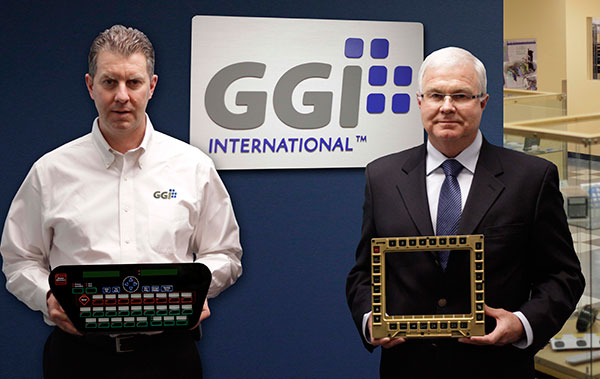By Leo Valiquette
GGI International’s roots date back to the early 1900s in the product identification business, when Verne John Graham introduced one of the first pressure sensitive adhesive products to Canada. His son Bernard John Graham later joined him in the business.
GGI has evolved significantly over the years. Today, the company is managed by brothers and shareholders Peter and Ian Graham. They have strategically positioned GGI as a global leader in the design, engineering and manufacturing of custom human machine interface (HMI) technologies, where printed electronics components often play an integral role.
There isn’t that much of a stretch between the company his grandfather and father built and the GGI of today, says Peter Graham.
“A century ago, conventional product identification relied on adhesives activated by water,” Graham said. “The arrival of pressure sensitive adhesives was a disruptive new technology much like printed electronics are today.”
GGI has always focused on what’s next, first with how a user interacts with a product and then with how people interact with machines. It’s always been about how to improve on the touch, feel, sight and sound of the user experience. GGI’s strength rests on a dynamic team of almost 200 that has a laser focus on innovation, customer satisfaction, product reliability and continuous improvement. The GGI team includes mechanical, electrical, industrial and chemical engineers, industrial designers and graphic artists, some with Masters and PhDs.
“When we enter the pre-design phase we put a heavy emphasis on the ergonomics of how a specific user will respond to the surface they are going to interact with,” Peter Graham said. “It’s all about that first impression.”
Membrane switches were just the beginning
GGI’s involvement with printable electronics began more than 20 years ago, with thin film conductive ink circuit layers embedded in its membrane switch technology. Today, GGI provides turnkey design, engineering and manufacturing of custom HMI assemblies. These include projected capacitive and resistive touch screens, complex PCBA assemblies, capacitive and/or mechanical switches, displays, injection-moulded plastics, machined bezels, and optically balanced lighting solutions, to name but a few.
On the printable electronics side, these capabilities today include thin film high-density screen-printed circuits and SMT expertise, capacitive touch sensors and touch screens, sensors and detectors, printed heating elements, flexible EL lamps and light emitting diffusers. As a Tier 1 member of Canada’s Printed Electronics Consortium, GGI’s R&D team works closely with the National Research Council’s Flagship Printed Electronics Program and the Communications Research Centre Canada.
Proudly ‘Made in Canada’
And all this takes place under one roof in Montreal. When other technology companies were moving their domestic manufacturing offshore or becoming the branch plant of a foreign multinational, GGI was making strategic investments in its future growth and levering its global supply chain.
In 2005, the company moved into its current state-of-the-art facility and adopted a lean manufacturing model that it has since extended to its design and engineering departments. GGI also invested in a top-notch enterprise resource planning (ERP) system capable of handling future growth as well as more complex products to respond to expanding client requirements.
Lastly, over the years the Grahams and their team have aggressively pursued key ISO and other quality certifications that give GGI the credentials required to serve Fortune 500 and Fortune 100 global customers that are leaders in such demanding market segments as aerospace, defence, medical and industrial controls. These certifications include AS9100C (aerospace and defence), ISO13485 (medical), ISO14001 (environmental) and ISO 9001. In the aerospace market, for example, GGI products are present and flying on both Boeing and Airbus commercial aircraft platforms with more than 30 airlines.
“We’ve equipped ourselves to do what is required to maintain and grow the business in those industries where there is an important focus on design and engineering expertise, product reliability and durability, and where your reputation as a manufacturer is also important,” Graham said. “We are extremely proud to be designing and manufacturing products in Canada and shipping to customers all over the world. You gain a lot of respect in the marketplace when you have been able to maintain and grow these relationships with customers in markets that carry such stringent standards.”
The drive to be smarter, smaller, lighter
It’s always been a matter of striking that balance between relying on the company’s core competencies and strengths while breaking new ground.
“We’ve always been a very focused organization,” Graham said. “We know what we’re good at and we try to stick with that as much as we can, while at the same time adding to the depth of our product offering so when we are face-to-face with a prospective customer, we will have something in our product lineup that will match their need.”
GGI may be a turnkey shop, but that doesn’t mean its continued success rests solely on the shoulders of its team. Levering relationships across its value chain also contributes to GGI’s success.
“We are continuously challenged to make things smaller, smarter and lighter, and while cost obviously plays an important factor, reliability does as well,” Graham said. “Talking to the forward thinkers among customers, suppliers and partners, to understand where they see the market is headed, allows you to stay ahead of the curve – that’s what gives us our edge.”
